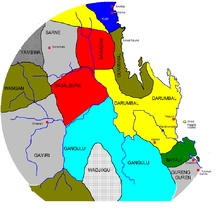The Baradha people, also spelt Barada and Thar ar ra burra, and also known as Toolginburra, were an Aboriginal Australian people of Central Queensland not far inland from the east coast.

Country
editBaradha lands, according to Norman Tindale's estimation, stretched over some 6,500 square kilometres (2,500 sq mi). They inhabited the area of the Connors River from Killarney north to Nebo. Their westward extension stopped around Bombandy.[1] They were wedged between the coastal Koinjmal and the Barna to their west. Their northern borders met with those of the Wiri.[2]
Social organisation
editThe Baradha, like the other Mackay area peoples, are said to have had two main social divisions, or phratries,[3] namely the Yungaroo and Wootaroo.[4] These classificatory terms are applied not only to the constituent groups, but to all natural phenomena, which are ascribed to either one or the other of the two basic classes.[a]
- Yungaroo are subdivided further into Gurgela and Gurgelan (male and female) and Bunbai and Bunnbaian.
- The Wootaroo are subdivided into Koobaroo and Koobarooan, masculine and feminine, and Woongo and Woongoan.[7]
At least two distinct sub-branches or kin groups are known to have formed part of the Baradha.
- Thararburra (Thar-ar-ra-burra), centered around Cardowan.
- Toolginburra, a name related to their word for "hill", namely tulkun.[1]
Language
editThe language spoken by the Baradha people was the Baradha dialect of the Biri language, which appears to be extinct, with no speakers recorded since before 1975.[8]
History of contact
editWhile sailing up Queensland’s east coast, Lieutenant James Cook sighted a group of mountains on the coastal plain of today’s Sunshine Coast, and named them the Glass House Mountains after the glass furnaces in Yorkshire. Aboriginal people had long used this area as a meeting place for ceremonies, trading, and gatherings. Cook first landed in Queensland at Round Hill (now known as Seventeen Seventy) on 24 May 1770.[9]
The area around Mackay began to be colonised in 1860, and, according to George Bridgeman,
During the eight or ten years which followed, about one-half of the aboriginal population was either shot down by the Native Mounted Police and their officers, or perished from introduced loathsome diseases before unknown.[10]
Bridgeman named the Baradha (Toolginburra) as one of the four Mackay tribes that suffered from this decimation,[10] part of the Australian frontier wars occurring throughout the colonies. Though the "dispersal" shootings are thought to have accounted for the majority of deaths, a measles epidemic struck the survivors in 1876, drastically reducing their numbers, and, according to one estimation, the remnants of the original people in 1880 amounted to no more than 100 people, with 80 evenly divided between men and women, and the remainder their children.[7]
Alternative names
editNatural resource management
editThe Traditional Owner Reference Group consisting of representatives of the Yuwibara, Koinmerburra, Barada Barna, Wiri, Ngaro, and those Gia and Juru people whose lands are within Reef Catchments Mackay Whitsunday Isaac region, helps to support natural resource management and look after the cultural heritage sites in the area.[11]
Notes
edit- ^ "When an Australian of the Port Mackay tribe says that the sun, snakes, etc., are of the Yungaroo phratry, he does not mean merely to apply a common, but none the less a purely conventional, nomenclature to these different things; the word has an objective signification for him. He believes that alligators really are Yungaroo and that kangaroos are Wootaroo. The sun is Yungaroo, the moon Wootaroo, and so on for the constellations, trees, plants, etc."[5][6]
Citations
edit- ^ a b c Tindale 1974, p. 165.
- ^ QGAG, p. iv.
- ^ Durkheim 2012, p. 142.
- ^ Bridgeman 1887, pp. 45–46.
- ^ Durkheim 2012, pp. 148–149.
- ^ Smyth 1878, p. 91.
- ^ a b Bridgeman 1887, p. 45.
- ^ E48 Baradha at the Australian Indigenous Languages Database, Australian Institute of Aboriginal and Torres Strait Islander Studies
- ^ Aboriginal people in Queensland: A brief human rights history (PDF). Copyright date 2017. Anti-Discrimination Commission Queensland. 25 July 2018. ISBN 978-0-9580054-5-6. Retrieved 17 October 2020.
Creative Commons Attribution 4.0 International licence (CC BY 4.0)
{{cite book}}: CS1 maint: others (link) - ^ a b Bridgeman 1887, p. 44.
- ^ "Traditional Owners". Reef Catchments. 9 September 2020. Retrieved 18 October 2020.
Sources
edit- Bridgeman, George F. (1887). "Port Mackay and its Neighbourhood" (PDF). In Curr, Edward Micklethwaite (ed.). The Australian race: its origin, languages, customs, place of landing in Australia and the routes by which it spread itself over the continent. Vol. 3. Melbourne: J. Ferres. pp. 44–51.
- Durkheim, Émile (2012) [First published 1915]. The Elementary Forms of the Religious Life. Translated by Swain, Joseph Ward. Dover Publications. ISBN 978-0-486-45456-6.
- Robertson, William (1928). Basedow, Herbert (ed.). Coo-ee talks: a collection of lecturettes upon early experiences among the Aborigines of Australia delivered from a wireless broadcasting station. Sydney: Angus & Robertson.
- Smyth, Robert Brough (1878). The Aborigines of Victoria: with notes relating to the habits of the natives of other parts of Australia and Tasmania (PDF). Vol. 1. Melbourne: J. Ferres, gov't printer.
- Tindale, Norman Barnett (1974). "Barada (QLD)". Aboriginal Tribes of Australia: Their Terrain, Environmental Controls, Distribution, Limits, and Proper Names. Australian National University. ISBN 978-0-708-10741-6.
- "Working Together on Country" (PDF). Queensland Government, Australian Government. Retrieved 26 January 2016.
Further reading
edit- Fox, M (1974a). "Legend of the Tha-ra-ra-burra tribe as to how the Sea was Made". Science of Man. 3 (4): 64.
- Fox, M (1974b). "Legend of the Tha-ra-ra-burra tribe as to how the Sea was Made". Science of Man. 3 (8): 136.